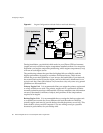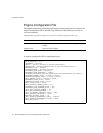Configuring an Engine
Chapter 4 Managing Engines 87
Governor The governor does not do much processing and does not require a
high performance server. It is recommended that you not assign it to the same
server as either the primary or backup engine unit, because it would then not be
able to distinguish between failure of the primary engine unit and a break in the
network link between the engine units.
Database Services The number and placement of database services depends on
load conditions. You must have enough database services running to prevent
database access requests from backing up in the database service router (see
“Viewing Performance Indicators” on page 222). In general, assign high priority
database services to a very capable server node, probably the same as the one on
which the database manager resides. If your database system provides network
access to the database, such as ORACLE’s SQL*Net, then lower priority database
services can be assigned to under-utilized servers, where resources are available to
help carry heavy loads on the engine. (If your database system does not provide
network access to the database, then your database services must reside on the
same node as your database manager.)
A typical configuration is illustrated in Figure 4-2 on page 88.
In this illustration the database services on Server4 are used in a round-robin
fashion unless the load on the engine is too heavy for them to carry it. In that case
the database service on Server1 is used. The database service on Server3 will be
used to handle peak loads, but will get less work than the service on Server1.
You did not have to decide at iIS installation time exactly which engine
components would be assigned to each server node because all component
partitions are installed on each server node that supports an engine. Instead, you
must select which components to start on which nodes when you configure each
engine.
For example, you can designate a default set of database services that are started at
engine startup time. Subsequently, however, you can start up additional database
services on designated nodes, as needed, to accommodate increasing load on the
engine.
The location of the primary and backup engine units is best determined in advance,
before startup time, and should not change because the shared library files
corresponding to process definitions registered with the engine are needed on all
the nodes on which the engine units are located. For this reason, moving the engine
units from one node to another can take a long time.
Your default engine component partitioning scheme is stored in an engine
configuration file, allowing you to design your basic engine component
partitioning scheme in advance and consistently start up your engine the same way
every time.


















